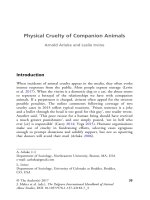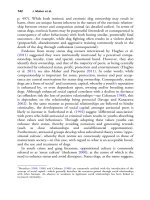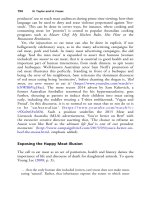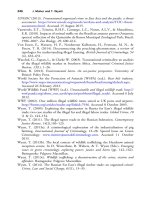The palgrave international handbook of a 443
Bạn đang xem bản rút gọn của tài liệu. Xem và tải ngay bản đầy đủ của tài liệu tại đây (39.99 KB, 1 trang )
Conservation and Invasive Alien Species: Violent Love
445
conceptualisation of the ‘relational nature’ of life on the planet, but was later
‘extrapolated and…mapped onto contiguous definable territorial units…for
national estate management purposes’. To Franklin (2015, p. 68), this move
exemplifies Alfred Whitehead’s ‘fallacy of misplaced concretism’ in that ‘a
theoretical understanding of a system of connections’ was wrongly extrapolated
to ‘territorially bounded spaces’.
The concept of IAS offers even more food for thought. Warren (2007)
offers an excellent parsing of this concept. As discussed earlier, there are three
criteria that go into the categorisation of an organism as invasive alien. The
first is spatial scale, and has to do with area, location or region. Alien species
are those that are found outside of ‘their natural range of distribution’
(IUCN 2015). The same animal elsewhere might be celebrated as ‘native’.
This ‘natural’ range is defined by examining the organism’s presence/absence
in a particular region at a particular point in time. For example, grey squirrels
are considered alien to the UK because they were not present on the island
before 1876 when they were introduced by humans (The Forestry
Commission UK 2015).
Time or temporal scale is the second criterion. Native species are those that
have been present in a region, without the aid of human introduction, since a
particular time in the past. Rabbits are considered alien and invasive to
Scotland because they were not there at the beginning of the current interglacial period and were introduced later on by humans. But they were present
in Scotland in previous interglacial periods (Warren 2007). Nonetheless, they
are categorised as ‘alien’ because a particular point in history is used as a cut-off
date for these classificatory decisions. Indeed, organisms that are classified as
‘native’ need not necessarily have been present in a region all through the time
period used as a cut-off. For example, red squirrels, an emblematic ‘native’
species in Scotland, went extinct in some parts of Scotland by the eighteenth
century because of extensive habitat loss and were later reintroduced from
Scandinavia and England (The Forestry Commission UK 2015).
Furthermore, the inherently partial and incomplete character of natural
history records means that ‘there is no reliable biological or ecological method
that can distinguish between aliens and natives’ (Peretti 1998, p. 185). The
spatio-temporal criteria used to decide whether an organism is alien or native
are ultimately a question of choice, and arguably, a political one. Particularly
telling is the increasing use of geopolitical borders as spatial criteria for
determining the ‘alien’ character of organisms. Conservation discourse
(McNeely et al. 2001) refers to organisms that are ‘alien’ to the USA or
India and recommends border control measures as key to the management
of invasives, thereby conflating geopolitical borders with biophysical ones.









